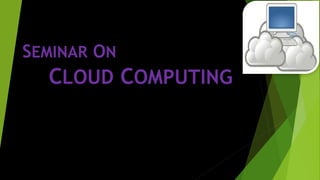
Seminar cloud computing
- 2. CONTENTS INTRODUCTION CHARACTERSTICS TYPES OF CLOUD COMPUTING ARCHITECTURE COMPONENTS ADVANTAGES DISADVANTAGES CONCLUSION REFERENCES
- 3. INTRODUCTION Cloud computing is Internet-based computing, whereby shared resources, software, and information are provided to computers and other devices on demand, like the electricity grid. Cloud computing is a paradigm shift following the shift from mainframe to client–server in the early 1980s. Details are abstracted from the users, who no longer have need for expertise in, or control over, the technology infrastructure "in the cloud" that supports them.
- 4. CHARACTERSTICS SELF HEALING SERVICE-ORIENTED LINEARLY SCALABLE SLA DRIVEN VIRTUALIZED FLEXIBLE
- 5. TYPES OF CLOUD COMPUTING
- 6. PUBLIC CLOUD Public clouds are made available to the general public by a service provider who hosts the cloud infrastructure. Generally, public cloud providers like Amazon AWS, Microsoft and Google own and operate the infrastructure and offer access over the Internet. With this model, customers have no visibility or control over where the infrastructure is located. It is important to note that all customers on public clouds share the same infrastructure pool with limited configuration, security protections and availability variances.
- 7. PRIVATE CLOUD Private cloud is cloud infrastructure dedicated to a particular organization. Private clouds allow businesses to host applications in the cloud, while addressing concerns regarding data security and control, which is often lacking in a public cloud environment. It is not shared with other organizations, whether managed internally or by a third-party, and it can be hosted internally or externally.
- 8. HYBRID CLOUD Hybrid Clouds are a composition of two or more clouds (private, community or public) that remain unique entities but are bound together offering the advantages of multiple deployment models. In a hybrid cloud, you can leverage third party cloud providers in either a full or partial manner, increasing the flexibility of computing. Augmenting a traditional private cloud with the resources of a public cloud can be used to manage any unexpected surges in workload.
- 9. ARCHITECTURE Cloud architecture, the systems architecture of the software systems involved in the delivery of cloud computing, typically involves multiple cloud components communicating with each other over application programming interfaces, usually web services.
- 10. COMPONENTS SaaS(Software as a Service): SaaS refers to software that’s made available as a web-based service. PaaS(Platform as a Service): Delivers development environment as a service. IaaS(Infrastructure as a Service): IaaS refers to computer infrastructure (e.g., virtualization) that’s delivered as a service. Cloud-based web services: Similar to Saas, web services in the cloud allow you to offer services online, such as credit card processing services, employee payroll processing or viewing an interactive map. MSP (Managed Service Providers): The grandfather of cloud computing, an MSP delivers applications to IT instead of end-users.
- 11. ADVANTAGES FLEXIBILITY: There is a high rate of flexibility when using cloud computing because people can opt out of using it whenever they want too. LOW COST: Companies can save big by employing cloud computing as it eliminates cost for hardware and software. SPEED & SCALES: Traditional methods to buy and configure H/W and S/W are time consuming. There is no need to purchase and setup H/W manually when using the cloud computing method. CUSTOMIZE SETTING: Cloud computing also allows you to customize your business app. This is a great benefit because the world of online business is very competitive.
- 12. DISADVANTAGES DEPENDENCY: One major disadvantages of cloud computing is user’s dependency on the provider. Internet users don’t have their data stored with them. RISK: Cloud computing services means talking services from remote servers. There is always insecurity regarding stored doc. because users don’t have control over their S/W. REQUIRES A CONSTANT INTERNET CONNECTION. MIGRATION ISSUE: Migration problem is also a big concern about cloud computing. If a user wants to switch to some other provider then it is not easy to transfer huge data from one provider to another.
- 13. CONCLUSION So, while cloud computing is really great and you’re probably already using it, either for business or for personal means. It’s a much better way to spread your resources, and it becomes easier to access things from longer distances.
- 14. REFERENCES www.google.com www.wikipedia.com www.studymafia.org www.infoworld.com
